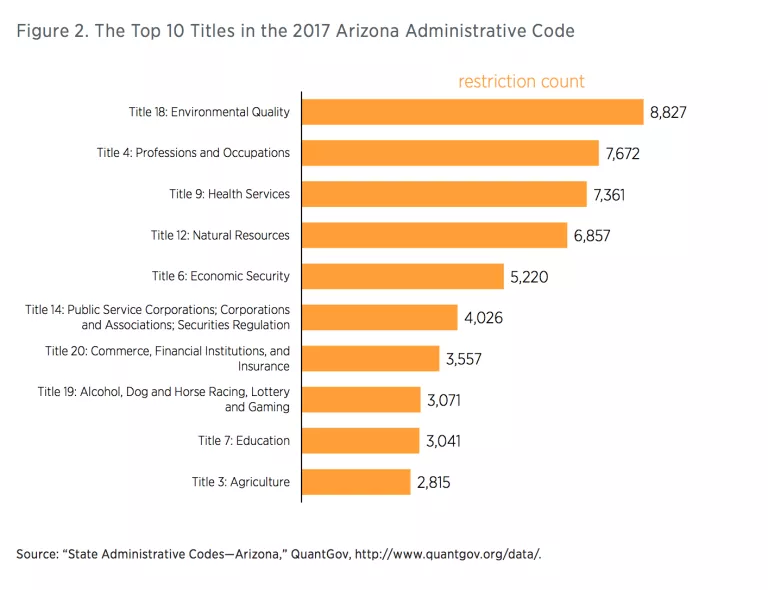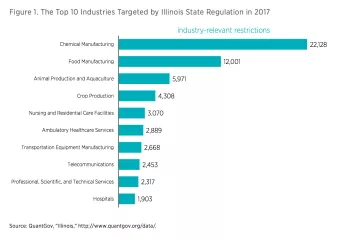- | Regulation Regulation
- | Policy Briefs Policy Briefs
- |
A Snapshot of Arizona Regulation in 2017
63,919 Restrictions, 5.6 Million Words, and 8 Weeks to Read
It would take an ordinary person over three years to read the entire US Code of Federal Regulations (CFR), which contained almost 112 million words in 2017. The sheer size of the CFR poses a problem not just for the individuals and businesses that want to stay in compliance with the law, but also for anyone interested in understanding the consequences of this massive system of rules. States also have sizable regulatory codes, which add an additional layer to the enormous body of federal regulation. A prime example is the 2017 version of the Arizona Administrative Code.
A tool known as State RegData—a platform for analyzing and quantifying state regulatory text—was developed by researchers at the Mercatus Center at George Mason University. State RegData captures information in minutes that would take an ordinary person hours, weeks, or even years. For example, the tool allows researchers to identify the industries most targeted by state regulation by connecting text relevant to those industries with restrictive word counts (also known as regulatory restrictions). These are words and phrases like “shall,” “must,” “may not,” “prohibited,” and “required” that can signify legal constraints and obligations. As shown in figure 1, the top three industries with the highest estimates of industry-relevant restrictions in the 2017 Arizona Administrative Code are chemical manufacturing, utilities, and ambulatory healthcare services.
State RegData also reveals that the Arizona Administrative Code contains 63,919 restrictions and roughly 5.6 million words. It would take an individual about 312 hours—or almost 8 weeks—to read the entire Arizona code. That’s assuming the reader spends 40 hours per week reading and reads at a rate of 300 words per minute. For comparison, in 2017 there were over 1.15 million additional restrictions in the federal code. Individuals and businesses in Arizona must navigate all of these restrictions to remain in compliance.
The titles of the Arizona Administrative Code are assigned based on the type of regulation housed within those titles. Figure 2 shows that in 2017, rules related to environmental quality, which are found in Title 18, contained over 8,800 restrictions. This makes it the biggest title, in terms of restrictions, in the Arizona code. Coming in second is Title 4, which is related to professions and occupations and includes over 7,600 restrictions.

Federal regulation tends to attract the most headlines, but it is important to remember that the nearly 112 million words and over 1.15 million restrictions in the federal code are just the tip of the iceberg when it comes to the true scope of regulation in the United States. States like Arizona write millions of additional words of regulation and tens of thousands of additional restrictions. State-level requirements carry the force of law to restrict individuals and businesses just as federal ones do.
Researchers are only beginning to understand the consequences of the massive and growing federal regulatory system on economic growth and other measures of well-being in the United States. Meanwhile, the effects of state regulation remain largely unknown. If this snapshot of Arizona regulation in 2017 is a good indicator, then the states are also active regulators, suggesting the true impact of regulation on society is far greater than that of federal regulation alone.


